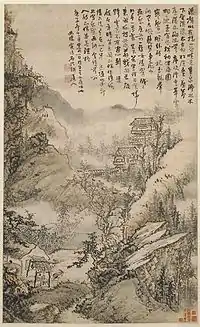Three perfections
Three perfections is the gathering of poets, calligraphers and painters to create an artwork in ancient China and Japan. The resulting product would be a painting that would include the work of a calligrapher to write a poem.

Legend holds that the Tang dynasty poets Du Fu and Li Bai were the first to introduce the combination of painting and poetry into one artwork. Several hundred years later, Su Shi, a poet and painter, promoted the use of poetry and painting together. Instruction of artists at the Northern Song Imperial Painting Academy included the integration of poetry and painting. As a result of the prevalence of the merged arts into the "Three perfections" a common expression emerged, the "soundless poem" to describe how one might experience a painting with sound, sight, smell, touch, and emotions.[1]
Examples
Gallery
._Detail%252C_Illustration_to_the_Second_Prose_Poem_on_the_Red_Cliff%252C_Nelson-Atkins_Museum_of_Art.jpg.webp)
_and_Wang_Ao_(poem)._Ode_to_Pomegranate_and_Melon_Vine._Detroit_Institute_of_Arts.jpg.webp) Shen Zhou (painting) and Wang Ao (poem), Ode to Pomegranate and Melon Vine, c. 1506–09, Detroit Institute of Arts
Shen Zhou (painting) and Wang Ao (poem), Ode to Pomegranate and Melon Vine, c. 1506–09, Detroit Institute of Arts
References
- The Great Art of China's 'Soundless Poems'. The Schiller Institute. p. 45, 70. Retrieved 28 August 2012.
Further reading
- Battista, Carolyn. (May 12, 1996). "Show of Three Perfections: Poetry, Painting and Calligraphy." The New York Times.
- Chinese Painting. Metropolitan Museum of Art.
- Los Angeles County Museum of Art / Three Perfections: Poetry, Calligraphy, Painting, July 26 – Nov 12. Los Angeles County Museum of Art.
- Sullivan, Michael. (1999). The Three Perfections: Chinese Painting, Poetry, and Calligraphy. George Braziller. ISBN 0-807-61452-1